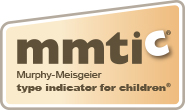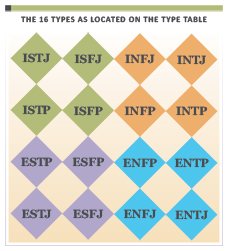Don't Box Me In: What is personality type, really?
In this blog, I will cover two main points. The first answers the question "What is personality type, really?" The second guides us on the clearest language to use when talking about personality type, or type. People who know me know how much the language we use when referring to type matters to me, because how we talk about type is directly linked to how we understand type. Let me explain.
Too often I hear people talk about personality type in a way that makes me cringe! "What's your type?" is tossed around with little regard to what that really means or what it is intended to mean. "I'm an INFJ! Cool! So is Oprah Winfrey, Princess Diana, Yoda, and Beagles!" at least according to some type enthusiasts. I admit, it may be fun finding out what animal or Disney character most represents your personality type, but although entertaining, it doesn't get to the real depth and value that type awareness offers.
Personality type is a system to help people understand themselves better. In particular, personality type describes the normal, healthy ways that people naturally direct their focus/energy, take in information, make decisions, and organize their lives. There are two opposite ways of managing each of these areas of living. One isn't any better or worse than the other; they have equal value. Type theory suggests that we use all these ways everyday but most of us will lean towards or prefer one more than the other; that preference will feel more natural and comfortable for us. There are eight preferences, also referred to as the four preference pairs (pairs of opposites).
Preference Pairs
Where we direct our focus and feel most energized (E-I):
Extraversion (E): focus on the outer world of people and events
Introversion (I): focus on the inner world of ideas and reflections
How we take in information (S-N):
Sensing (S): notice details, collect facts, concrete, focus on the present
Intuition (N): notice the big picture, enjoy possibilities, abstract, focus on the future
How we make decisions (T-F):
Thinking (T): using logic, analysis, with an objective stance
Feeling (F): using compassion, considering values, with an empathetic stance
How we organize our lives (J-P):
Judging (J): likes structure, making plans, and keeping to schedules in an organized environment
Perceiving (P): likes spontaneity, being flexible, and adapting to open-ended environments
To reiterate, we do all the above, but most of us will prefer to use either Extraversion or Introversion, Sensing or Intuition, Thinking or Feeling, and Judging or Perceiving. Preference, in this context, is analogous to whether we are right or left-handed. We use both hands every day but prefer one hand over the other. This is just like personality type. One preference, within a preference pair, will feel natural and comfortable so that we tend to use that preference more often because we don't have to think about it very much. However, we do use the opposite preferences, too, but it can feel awkward, and we may feel less competent and confident when we use them, just like using our non-preferred hand. When the preferences are combined, we end up with 16 four-letter personality types. For example, ENFJ, ISTP, ESTJ, and so on.
Another way to think of our preferences is through the terms strengths and stretches. Because the preferences of your four-letter type are innate (inborn) they reflect your natural strengths in life. The opposite of those preferences are considered your stretches (e.g., the preference opposite Extraversion is Introversion or the preference opposite Thinking is Feeling, etc.). We do use them, but it may be more challenging to do so. In other words, we may have to "stretch" from our natural styles when a situation calls for it. We don't choose our strengths or stretches. However, we can choose our behavior; we can choose to use our strength or stretch in any situation. Limiting ourselves (or others) based on the four letters of our personality type doesn't represent type theory at all. Type is not meant to box you in; it is designed to help us understand ourselves and others better.
The concept of a personality type preference leads to my second point: the language we use when we talk about type. Our type is not meant to lock us in a box. First, we are much more than four letters; humans are complex beings. Personality type is part of who we are and is valuable as a tool for self-understanding. People will often make statements like, "I am an ISTP." But remember, we use all eight preferences, so a better way to say this is, "I prefer ISTP." By describing your type in this way, it tells others what you prefer to do in most situations but that if required you could stretch to the opposite preferences when appropriate. That doesn't mean it will be easy, it just means you can choose to do so.
"Extravert", "introvert", "sensor", "intuitive", "thinker", "feeler", "perceiver", and "judger", are terms often used to describe personality type and once again, this causes me to wince! This kind of language confines us. It says we are only one way and discounts our ability to stretch. Rather, I would say that I prefer Feeling, but at times I need to call upon the Thinking process to help me make an objective decision. Naturally, I lean into the Feeling preference and as a child I leaned on it predominantly. Type develops over the lifespan, a topic for a later blog, meaning that young people focus more on their natural strengths as they develop and learn to use them. As we mature, we begin to use and tend to feel more comfortable when using our stretch, especially if we have been working on personal type development.
So, the next time someone asks you what your personality type is, say that you have a preference for ENTJ, for example, or that you prefer Thinking or Judging. The key here is not to limit yourself in your language or your life. Develop your natural style, your strengths, and pay attention to when you might need to stretch. Good type development is all about honoring your strengths, understanding, and appreciating your stretches, and recognizing which one is appropriate to use in any given situation.



_thumb.png)





.png)









.png)
x.png)
.png)
.png)

